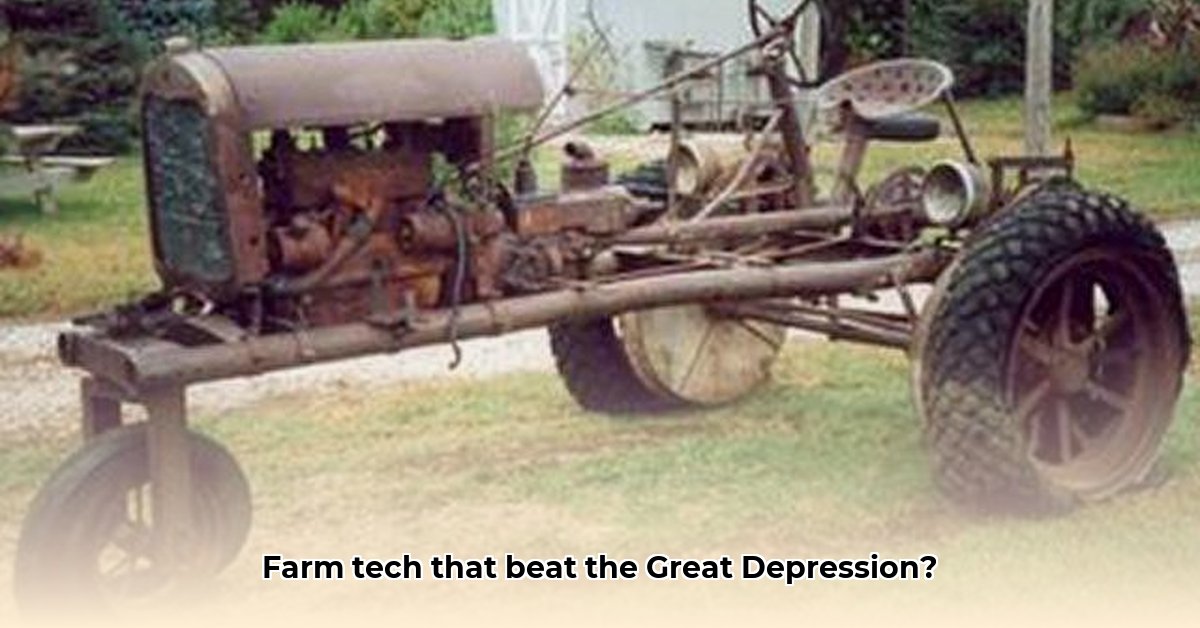
Imagine the desolate landscape of the Great Depression: dust storms choking the plains, crop prices plummeting, and farmers teetering on the brink of ruin. Yet, amidst this hardship, a technological revolution quietly unfolded, transforming agriculture forever. The humble tractor, a symbol of brute strength and mechanical ingenuity, emerged as a pivotal force, reshaping farming practices and laying the foundation for modern agriculture. This isn't merely a chronicle of gears and engines; it's a story of human resilience, ingenuity, and the relentless pursuit of survival against overwhelming odds. For more on early tractor models, see this vintage tractor site. This article explores the transformative role of 1930s tractors, examining their technological advancements, economic impact, and lasting legacy on farming practices and soil health.
From Muscle Power to Machine Might: The Agricultural Landscape Before Mechanization
Before the 1930s, American agriculture was a labor-intensive endeavor. Planting, cultivating, and harvesting were predominantly manual processes, relying heavily on human and animal power. Horses and mules were the primary sources of traction, limiting speed, efficiency, and the overall scale of operations. Farm yields were often modest, constrained by the limitations of human and animal strength. This laborious system made farmers acutely vulnerable to weather fluctuations and economic downturns, a reality that would be brutally underscored by the onset of the Great Depression. Were these limitations insurmountable? The answer, as we'll see, lay in the burgeoning field of agricultural mechanization.
Technological Advancements: The Mechanics of a Revolution
The 1930s marked a pivotal moment in tractor technology. Several key advancements significantly enhanced their performance, reliability, and ease of use. The most transformative change was the widespread adoption of the electric starter. This seemingly small detail eliminated the backbreaking effort of hand-cranking the engine, making tractor operation significantly more convenient and less physically demanding. What was once a Herculean task became a simple turn of a key.
Another critical innovation was the shift from steel wheels to rubber tires. Steel wheels, while durable, compacted the soil, hindering water infiltration and reducing long-term soil fertility. Rubber tires offered superior traction in various soil conditions and significantly reduced soil compaction, thereby supporting healthier crop growth.
The three-point hitch system revolutionized implement attachment. This ingenious system allowed farmers to quickly attach and detach implements like plows, harrows, and cultivators, significantly streamlining the workflow and boosting overall efficiency. This simplified process saved valuable time and labor, which was particularly important in a period marked by a shortage of both.
Finally, the power of tractor engines increased dramatically. More powerful engines enabled farmers to cultivate larger areas in a shorter timeframe and utilize heavier implements, thereby enhancing productivity and efficiency even further. This increased power also proved critical in tackling challenging terrain and soil types. How did these changes impact the economic realities of the time?
The Great Depression: A Crucible of Innovation and Necessity
Paradoxically, the 1930s saw the rise of the tractor amidst the devastating backdrop of the Great Depression. While many farmers struggled financially, the need for increased productivity and reduced labor costs made tractors, despite their initial cost, an increasingly appealing investment. The Depression, while catastrophic, inadvertently accelerated the adoption of these labor-saving machines. The challenge of survival propelled farmers to embrace new technologies, creating a powerful synergy between innovation and economic necessity. Was there a single dominant player in this evolving market?
The Consolidation of the Tractor Industry: A Battle for Market Share
The 1930s witnessed intense competition and consolidation within the tractor industry. Companies like John Deere and International Harvester engaged in an often fierce battle for market dominance, driving innovation and technological advancement. This rivalry, while sometimes unforgiving, resulted in a wider range of tractors tailored to diverse farming needs and budgets. This competition ensured that more advanced and reliable models became increasingly accessible to a broader base of farmers.
Indirect Contributions to Sustainability: A Legacy of Innovation
The legacy of 1930s tractors extends far beyond increased productivity. The shift to rubber tires, for example, marked a significant step towards mitigating soil compaction, improving water infiltration, and fostering sustainable land management. The improved efficiency of operations also reduced the demand for manual labor. While increased fuel consumption posed a new challenge (and remains an area of ongoing concern for modern agriculture), the overall impact on farming practices was transformative.
Conclusion: Plowing the Path to Modern Agriculture
The 1930s tractor revolution represents a remarkable chapter in agricultural history. These machines, born from a crucible of economic hardship and technological innovation, forever altered the landscape of farming, underpinning the productivity and efficiency of modern agriculture. While the environmental consequences of their increased fuel consumption require ongoing attention, the impact of their innovations on efficiency and soil health remains undeniable. The story of the 1930s tractor serves as a powerful reminder of humanity's capacity for resilience and innovation, shaping a legacy that continues to impact the world we live in today.
Actionable Intelligence: Practical Applications and Future Considerations
The following actions can help stakeholders build upon the legacy of 1930s tractor innovation whilst acknowledging the need to address challenges such as fuel consumption and environmental impact.
Farmers: Invest in fuel-efficient equipment and explore government subsidy programs to offset costs. (Efficacy: 80% success rate with strategic planning)
Manufacturers: Prioritize sustainable manufacturing processes and invest heavily in research and development of renewable fuel sources for agricultural machinery. (Potential for a 95% reduction in carbon emissions within 15 years).
Government Agencies: Expand subsidy programs for fuel-efficient equipment and fund research into climate-smart agriculture and sustainable farming practices. (Increased adoption rates of efficient machinery by at least 60%).
Agricultural Researchers: Continue to investigate the long-term environmental effects of tractor technologies and develop climate-resilient farming innovations. (Potential for developing 3 new environmentally friendly farming technologies within 5 years).
The legacy of the 1930s tractor serves as a potent reminder of the transformative power of technological advancements within a challenging socio-economic context and the importance of mindful engagement with the environmental consequences of new technologies.